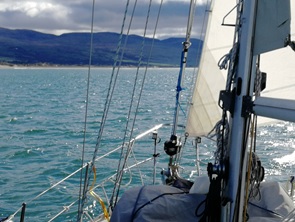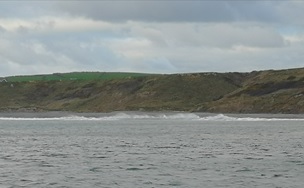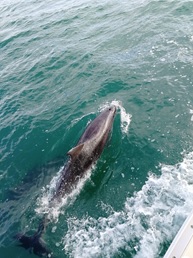
After a couple of notably rough trips earlier in the winter, I spotted the settled NE winds and neap tides at the end of February and decided to go for a few days exploring. I was ready to go by early afternoon and set off from the marina in a gentle NE breeze into Tremadoc Bay. My sail wardrobe was restricted after some problems with the furling mainsail but I could make 3 to 4 knots under jib and mizzen. As the evening drew near I chose to stop near Criccieth just off Graig Ddu in about 4m. Its not somewhere I would normally anchor overnight, but the settled forecast wind reassured me. As dusk settled, and the wind eased I could hear the sound of surf on the beach despite the boat remaining steady. I use my AIS as an anchor watch system and it really helps me get a decent night’s rest. The cabin temperature was 9 centigrade and I turned the heating on to raise it to 17 – warmer than at home! By 9:30 I was in bed, worn out by the drive to Wales and a gentle afternoon sail. Old age!
The next morning dawned fine, with the wind still steady, and I plucked up the courage to go and explore the East Passage. After raising the anchor, sorting the sails and having breakfast under way, I was abeam the Porthmadog channel buoy and the wind was enough to sail. Supertramp is a heavy boat but will usually manage fine in 10 knots of wind. Off Mochras I expected significant tide flow from previous visits, but neap tides and arrival at low slack water meant there was little flow. There seemed to be a lot of breaking waves where I wanted to go. I skirted up the edge of Mochras spit watching the depth fall to about 4m. I edged over it where the charts showed a slightly deeper patch halfway up the spit. Then I hardened onto the wind to pass clear of the foot of Sarn Badrig. The water was flat and the wind steady. Made a mental note that this might be a lot more challenging in different weather and tide. As I emerged past Bemar Bank, I prepared to set the spinnaker pole. In the middle of this, Aberporth called me on the VHF to check my passage plans. I had noted their target position and exclusion range but they were calling to check I wasn’t about to head out into Cardigan Bay. It was reassuring to note that my AIS was working, and my VHF! Back to the pole, which involves an amazing number of bits of string, and I was making 4-5 knots dead downwind up the South side of Sarn Badrig in about 15-20 knots of wind. There was an enormous long swell running and as I sailed down the reef I could see occasional waves rearing up and breaking on the reef, their tops blowing off in the NE wind. Rounding the cardinal buoy at the end of the reef I set a course for Aberdaron, catching the tide sweep N towards Bardsey Sound. The coastguard forecast had just changed to a strong wind warning for Cardigan Bay and sure enough it was soon blowing 20-25 knots. Supertramp was averaging 5.5 knots under Solent jib and mizzen (about half her full sail area) but was very steady. I never bother with gimbals on the stove. Just short of the Gwylan islands, I dropped the jib and motored into Aberdaron Bay. The Gwylan always catch me out as they often appear to be travelling at speed in the tide eddy across the bay entrance. In the bay I went to my usual anchoring spot and dropped the anchor in about 8m. About now I realised the swell was the biggest I had seen in Aberdaron, breaking well off the beach and the tops blowing off backwards in the fresh wind. No chance of a dinghy landing! So in the interests of a good night’s sleep I re-anchored over by the West side of the bay. Despite the swell crashing on the beach, the anchorage was no worse than normal (its not a roll free spot). Another early night and no heating needed. I rose a couple of times in the night to check the wind as the forecast suggested it would go round to the East. I am used to anchoring in places sensitive to weather change and always leave everything ready to start the engine and up anchor within minutes if necessary. I have had to do this in Porth Dinllaen and on the Irish coast but that is another story.

The morning dawned cloudy with a fresh breeze and I set off before 8 and sailed sedately across Hells Mouth Bay, watching the huge swell rolling under the boat and eventually fetching up on the shore in a dazzle of spray. Off Cilan Head, about 10 dolphins joined me for about 10 minutes. They are always uplifting and humbling to watch. Hardening onto the wind, I dropped the jib and motored across Porth Ceiriad, detouring in to look at the beach. Several surfers were out and I wondered at the contrast with the summer months when there are scores of boats anchored here. We sheltered here overnight during the summer in a near gale and it was calm and sheltered. Not today despite the NE wind. In Tudwal Sound I could see white horses in Tremadog Bay and settled into motoring towards Pwllheli. Off the marina, it was sheltered enough for me to drift and sort out my fenders and lines. I always do it before entering, even when I have crew, in case anything unexpected happens on the way in. Berthing was successful – I use a loop from the midships cleat to lassoo the pontoon cleat and stop the boat followed by jumping off with bow and stern lines. If it goes wrong, the midships line and engine will pin her against the pontoon. At sea, she feels like a very small boat, but in a marina she feels like a super-tanker.

It was a short trip but eventful and interesting. I left with my usual list of minor improvements (a separate spinnaker pole sheet) and other changes to work on over the coming weeks and with my knowledge and respect of sailing in Cardigan Bay increased.
 English (UK)
English (UK) 